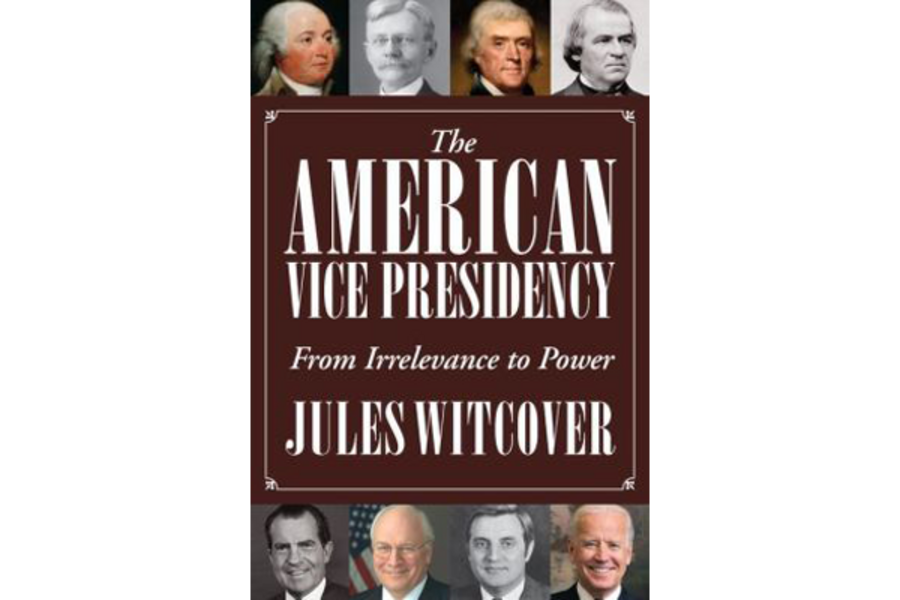'The American Vice Presidency' sketches all 47 men who held America's second-highest office
Loading...
There is nothing imaginative about the organization of The American Vice Presidency, Jules Witcover’s new book about vice presidents of the United States. After an eight-page introduction, Witcover, one of the most respected political journalists anywhere, provides biographical sketches of all 47 men (and they are, unfortunately, all men) described as “a heartbeat away” from the White House.
Okay, history buffs: Who is featured in chapter one? You know, the vice president during the presidency of George Washington? Did you reply “Thomas Jefferson”? Wrong. The correct answer: John Adams. After Adams? That’s right: Thomas Jefferson. And after Jefferson? Aaron Burr. Wait, wasn’t Burr a criminal, banished from the fledgling United States of America? Yes. But he served as vice president before departing.
It is no surprise that Witcover would write this book – after all, he has published full-length biographies of vice presidents Spiro T. Agnew and Joseph R. Biden Jr. But my goodness – the amount of research Witcover had to conduct to publish this book is astounding. Writing short sometimes consumes less time than writing long, and Witcover’s biographies of each vice president are relatively short; none is longer than 14 pages. But still, as a reader, the amount of detail based on research left me exhausted – in a good way.
Serious scholars of American history will learn a lot. So will trivia buffs. And everybody else. It is not so difficult to imagine somebody on a television game show choosing the category “American vice presidents” and successfully answering a question about, say, vice president Charles W. Fairbanks of Indiana. Who, you ask? You know, Charles W. Fairbanks, the 26th vice president of the United States.
Along with biographical details, Witcover places the prestige and power of vice presidents into historical context. Or, more accurately, the lack of prestige and power. Initially, the vice president was simply the runner-up in the presidential election. That decision, naturally, meant a president served one political party while the vice president served the rival political party. Eventually, tradition suggested that the president and vice president call the same political party their ideological home.
Decade after decade, the importance of the vice presidency seemed so minor that hardly anybody felt certain exactly how to replace a president who died during his term. It took the US Congress and other political leaders until 1967, with adoption of the 25th amendment to the US Constitution, to clarify the vagaries of vice-presidential succession to the White House.
While frustration is the dominant theme coursing throughout the 47 biographies, Witcover includes plenty of upbeat anecdotes about the early lives of those who became vice president, about their friends and family members, about accomplishments during the term of service. As everybody knows, some of those frustrated vice presidents did attain the presidency, either through premature death of the chief executive, or through the normal electoral process. And sometimes both, as was the case with Lyndon Baines Johnson, who became president after the assassination of John F. Kennedy, and then won a four-year term at the polls.
Witcover does not avoid anomalies and scandals. Arguably, the biggest mess involved vice president Thomas R. Marshall of Indiana, vice president to Woodrow Wilson. After Wilson became seriously ill, his wife Edith, his political allies, and his medical advisers refused to disclose whether Wilson was well enough to make crucial decisions as president. Marshall was not among the knowledgeable, and so he experienced confusion as to how, or even whether, to exercise certain powers. He could have initiated a scandal about the secrecy imposed by Edith Wilson. Instead, he decided against exposure.
Witcover’s opinion: “In the restraint and grace [Marshall] displayed in those dark days when Wilson seemed at death’s door and the presidency might well have passed to him, [Marshall] demonstrated qualities that earned him distinction in the vice presidency that few other occupants, past or present, have ever achieved.” However, as Witcover explains, that virtue did not lead to the White House. Marshall expressed interest in the run-up to the 1920 presidential election, but found little support outside his home state.
Back in the present, Witcover suggests that contemporary presidential candidates reveal important qualities in their choice of a vice president: “Failure to act wisely and soberly should raise serious public doubts concerning the presidential nominee’s own worthiness to assume the nation’s highest office.”
Steve Weinberg is writing a biography of Garry Trudeau. Weinberg is the author of eight previous nonfiction books.








